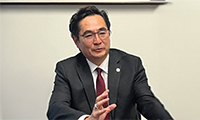
Ben S. Bernanke, right, the Federal Reserve chairman, and Treasury Secretary Henry M. Paulson Jr. are working to halt the upheaval.
This article was reported by Peter Baker,Stephen Labaton and Eric Lipton and written by Mr. Baker.WASHINGTON - For the last year, as the American economy lurched from crisis to crisis, the chairman of the United States Federal Reserve, Ben S. Bernanke, had been warning Henry M. Paulson Jr., the United States Treasury secretary, that the worsening situation might ultimately force a sweeping intervention by the federal government.
A longtime student of the Great Depression, Mr. Bernanke was acutely aware of what could happen without a decisive move. Finally, the moment that called for action arrived late on Wednesday, September 17. Less than 24 hours after the Federal Reserve had bailed out American International Group, the giant insurer, it was clear that the turmoil gripping Wall Street was only growing worse and that ad hoc solutions were not working.
Talking into a speaker phone from his ornate office, Mr. Bernanke told Mr. Paulson that it was time to adopt a comprehensive strategy that the United States Congress would have to approve. Mr. Paulson understood. Previously reluctant to send Congress a plan that lawmakers had warned had little chance of quick passage, he had worried that a rejection would only further shock the markets. But during two conference calls on that Wednesday night and Thursday morning, he agreed that they had no choice.
“It just happened dramatically,” Mr. Paulson said in an interview on September 19. “There was only one way that we could reassure the markets and deal with a very significant and broad-based freezing of the credit market. There was no political calculus. It was overwhelmingly obvious.”
Just like that, Mr. Bernanke, the reserved former Ivy League professor, and Mr. Paulson, the hard-charging former Wall Street deal maker, launched what would be the United States government’s largest economic rescue operation in modern times, one that rivals the Iraq war in cost and may redefine Washington’s role in the marketplace for years.
The plan to buy $700 billion in troubled assets with taxpayer money was shaped by two men who did not know each other until two years ago, but now find themselves brought together by history. If Mr. Bernanke is the intellectual force and Mr. Paulson the action man of this unlikely tandem, they have managed to create a nearly seamless partnership as they rush to stop the financial upheaval .
Along the way, they have cast aside the administration’s long-held views about regulation and government involvement in private business.
“There are no atheists in foxholes and no ideologues in financial crises,” Mr. Bernanke told colleagues at one meeting, according to a participant.
The improvisational nature of their effort has turned President Bush and Congressional Democrats into virtual bystanders, sometimes uncertain about what comes next.
Mr. Bernanke took office in February 2006 and Mr. Paulson five months later, both Republicans and Bush appointees, yet arriving from starkly different places. Mr. Bernanke, 54, had developed a conciliator’s style as chairman of Princeton University’s economics department. Mr. Paulson, 62, rose to the top of the investment bank Goldman Sachs by working the phones and pounding the occasional table.
“Hank is just the most hyperactive, getit- done kind of guy who’s always trying to get the problem solved and move on. He’s impatient to fix things,” said Allan B. Hubbard, a former national economic adviser to Mr. Bush.“Ben is much more low-key. He’s very thoughtful. He’s an incredible thinker, listens well, analyzes well and is not intimidated by anyone. It’s probably a great pair.”
The Hammer, as Mr. Paulson has been called since he played football at Dartmouth College, brought to Washington his characteristic intensity. “He is a hurricane. He is used to living in a turbulent world,” said John H. Bryan Jr., a friend and former chief executive of the Sara Lee Corporation, the consumer-goods company.
Mr. Bernanke has a more obscure nickname, Helicopter Ben, after a speech he gave in 2002 in which he talked about the Feds helicopter drops” of emergency money to keep the system liquid.
For Mr. Bernanke, the current crisis is the culmination of a lifetime of figuring how the system works from a theoretical viewpoint. He knew long ago that he might someday be called on to act on his studies. Vincent R. Reinhart, a former Fed official, said Mr. Bernanke’s research into Japan’s financial crisis in the 1990s had reinforced his view that government had to be aggressive in market crises.
Mr. Paulson said Mr. Bernanke had long warned that a moment might come like the one they saw recently. “Going back a long time, maybe a year ago, Ben, as a worldclass economist, said to me, ‘When you look at the housing bubble and the correction, if the price decline was significant enough,’ ” the only solution might be a large-scale government intervention, he said.
Mr. Paulson said he agreed but hoped it would not come to that. “I knew he was right theoretically,” he said. “But I also had, and we both did, some hope that, with all the liquidity out there from investors, that after a certain decline that we would reach a bottom.”
스마터리빙
more [ 건강]
[ 건강]이제 혈관 건강도 챙기자!
[현대해운]우리 눈에 보이지 않기 때문에 혈관 건강을 챙기는 것은 결코 쉽지 않은데요. 여러분은 혈관 건강을 유지하기 위해 어떤 노력을 하시나요?
 [ 건강]
[ 건강]내 몸이 건강해지는 과일궁합
 [ 라이프]
[ 라이프]벌레야 물럿거라! 천연 해충제 만들기
 [ 건강]
[ 건강]혈압 낮추는데 좋은 식품
[현대해운]혈관 건강은 주로 노화가 진행되면서 지켜야 할 문제라고 인식되어 왔습니다. 최근 생활 패턴과 식생활의 변화로 혈관의 노화 진행이 빨라지고
사람·사람들
more많이 본 기사
- 세계 곳곳서 ‘美규탄’ 시위…마두로 아들 “거리로 나와달라”
- 美 ‘유령 특수부대’ 델타포스
- 베네수엘라, 세계 최대 매장량이라는데…국제유가도 영향받나
- ‘국민 배우’ 안성기 별세…69년 연기 인생 마침표
- 美, 베네수 부통령에 압박 “마두로와 다른 선택하길”
- [美 마두로 축출] 마두로 베네수엘라 대통령, 5일 법정 첫 출석
- 코미디부터 예술영화까지… ‘천의 얼굴’로 스크린 누빈 안성기
- 이부진 호텔신라 사장 NBA 중계화면에…아들과 함께 미국서 휴가
- 故김영인 누구?..故송도순 이어 별세, 슬픔에 빠진 방송계
- [CES 2026] 6억달러 새단장한 우아한 전시장…내부엔 지게차 동원 개막준비
- 아이유♥변우석·지성·신하균·유연석.. ‘2026 MBC 연기대상’ 벌써 치열하다
- 美, 직접통치아닌 압박통한 정책개입 가닥… “함포외교”
- [美 마두로 축출] 뉴욕 구치소 수감된 마두로… “좋은 밤이에요” 인사도
- 여야 새해도 극한대치… ‘종합·통일교특검’ 법사위 첫 戰場 예고
- [美 마두로 축출] 미 곳곳서 반전시… 1
- 젤렌스키 “이달 내로 종전안 놓고 美 정상회의 희망”
- 임재범, 은퇴 발표 “박수칠 때 떠나겠다”
- 20kg 빼고 아이돌 외모 되찾더니..강남, 기안84와 북극 마라톤 도전
- [CES 2026] 우유 꺼내고 수건 개는 로봇…LG ‘가사 해방’ 속도
- 李대통령 “中, 한반도 평화 파트너…… 1
- 영종도 인천공항 잇는 3번째 다리 내일 개통…요금 2천원
- 국힘에 ‘살려달라’고 문자 메시지?…이혜훈측 “전혀 사실 아냐”
- [美 마두로 축출] 트럼프 ‘서반구 패권’ 구상 본격화하나…중남미 긴장 고조
- 美 경제석학 “韓 원화가치 매우 저평가…향후 회복할 것”
- [美 마두로 축출] 한밤 안가 급습 ‘확고한 결의’ 작전… “침실서 끌어내”
- ‘연프 중독’ 고준희, 눈 성형 고백에 풍자 “과연 눈만 했을까?” 의심
- [美 마두로 축출] 트럼프, 두번째 중대 군사작전…北이 받을 메시지는
- 北, 탄도미사일 발사… ‘마두로 축출’ 파장 속 무력시위
- [美 마두로 축출] 갈라진 지구촌…쏟… 1
- 김병기, 경찰에 줄고발… ‘아들 취업청탁·편입시도’ 진술도
- [美 마두로 축출] 루비오 국무장관, 베네수 부통령에 “마두로와 다른 선택하길”
- [美 마두로 축출] 트럼프 “베네수엘라 부통령이 잘하면 미군 주둔 안해”
- “韓 독립혼 상징”…재조명되는 현대차그룹 상하이 임정 보존활동
- ‘종합선수권 10연패’ 차준환, 3연속 올림픽행 “꿈의 무대... 모든 것 보여주고 오겠다”
- ‘에릭♥’ 나혜미, 두 아들과 일상 공개..짱구 볼살+붕어빵 눈매 “우리 강아지들”
- “황희찬 시즌 최고의 퍼포먼스” 극찬, 웨스트햄전 1골·1도움 폭발... 울버햄프턴 ‘EPL 20경기 만에 감격 첫 승’
- [美 마두로 축출] 체포된 마두로 부부, 뉴욕 도착…다음주 재판받을 전망
- BBC “입소문서 시작한 K-뷰티, 전세계 스킨케어 루틴으로”
- [美 마두로 축출] 서반구·마약·석유…트럼프 작전배경의 세 키워드
- 해넘긴 미중정상회담 합의문 발표…무역합의 불확실성↑
- [美 마두로 축출] 트럼프 “베네수엘라 부통령이 잘하면 미군 주둔 안해”
- [美 마두로 축출] 유엔 안보리, 5일 긴급회의…베네수 소집요청
- ‘왕따 주행 논란’ 억울함 푼 김보름 “말로 담기 어려운 시간 지나...” 현역 은퇴 선언
- 李대통령, 오늘 국빈 방중 출국…비핵화·한한령 ‘돌파구’ 주목
- 슈 “임효성과 부부 싸움..연락처 차단·집 비밀번호 바꿔”
- ‘밀라노행 확실시’ 피겨 차준환, 올림픽 2차 선발전 쇼트 1위... 프리 스케이팅 예정
- 美, 마두로 전격 체포·압송…트럼프 “정권이양까지 베네수 통치”
- [美 베네수 공격] 유엔총장 “국제법… 1
- 中관영매체 “李대통령 중요시점 방중…… 1
- 트럼프 “안전한 정권이양 때까지 미국이 베네수엘라 통치”(종합)
1/5지식톡

-
 미 육군 사관학교 West Poin…
0
미 육군 사관학교 West Poin…
0https://youtu.be/SxD8cEhNV6Q연락처:wpkapca@gmail.comJohn Choi: 714-716-6414West Point 합격증을 받으셨나요?미 육군사관학교 West Point 학부모 모…
-
 ☝️해외에서도 가능한 한국어 선생님…
0
☝️해외에서도 가능한 한국어 선생님…
0이 영상 하나면 충분합니다!♥️상담신청문의♥️☝️ 문의 폭주로 '선착순 상담'만 진행합니다.☎️ : 02-6213-9094✨카카오톡ID : @GOODEDU77 (@골뱅이 꼭 붙여주셔야합니다…
-
 테슬라 자동차 시트커버 장착
0
테슬라 자동차 시트커버 장착
0테슬라 시트커버, 사놓고 아직 못 씌우셨죠?장착이 생각보다 쉽지 않습니다.20년 경력 전문가에게 맡기세요 — 깔끔하고 딱 맞게 장착해드립니다!장착비용:앞좌석: $40뒷좌석: $60앞·뒷좌석 …
-
 식당용 부탄가스
0
식당용 부탄가스
0식당용 부탄가스 홀세일 합니다 로스앤젤레스 다운타운 픽업 가능 안녕 하세요?강아지 & 고양이 모든 애완동물 / 반려동물 식품 & 모든 애완동물/반려동물 관련 제품들 전문적으로 홀세일/취급하는 회사 입니다 100% …
-
 ACSL 국제 컴퓨터 과학 대회, …
0
ACSL 국제 컴퓨터 과학 대회, …
0웹사이트 : www.eduspot.co.kr 카카오톡 상담하기 : https://pf.kakao.com/_BEQWxb블로그 : https://blog.naver.com/eduspotmain안녕하세요, 에듀스팟입니다…
케이타운 1번가
오피니언
 손영아 문화 칼럼니스트 / YASMA7 대표
손영아 문화 칼럼니스트 / YASMA7 대표 [손영아의 문화산책] ‘슈만의 연가’… 170년 전 멈춘 시간, 끝나지 않은 사랑
 김재천 서강대 국제대학원 교수
김재천 서강대 국제대학원 교수 [김재천 칼럼] 2026년, 미·중 대타협은 가능할까
 조지 F·윌 워싱턴포스트 칼럼니스트
조지 F·윌 워싱턴포스트 칼럼니스트 [조지 F. 윌 칼럼] AI 투자 붐이 걱정된다면?… 역사적 맥락을 보라
 이희숙 시인·수필가
이희숙 시인·수필가 [금요단상] 차가운 길, 이불 한 장의 온기
 한영일 / 서울경제 논설위원
한영일 / 서울경제 논설위원 [만화경] 33년만에 퇴역하는 장보고함

[왈가 왈부] 이혜훈 ‘정말 널 죽였으면’ 폭언, 장관직 수행 가능할까요
 정숙희 논설위원
정숙희 논설위원샴페인, 마지막 날과 첫날을 위하여
 조지 F·윌 워싱턴포스트 칼럼니스트
조지 F·윌 워싱턴포스트 칼럼니스트 [조지 F. 윌 칼럼] 저무는 2025년에 안도의 한숨
 김동찬 시민참여센터 대표
김동찬 시민참여센터 대표 [미국은 지금] 책임 있는 자본 없으면 커뮤니티 미래도 없다
1/3지사별 뉴스

뉴욕시 첫 무슬림 시장 맘다니 취임
미국 최대도시이자 경제 수도로 꼽히는 뉴욕시의 첫 무슬림·남아시아계 시장이자 스스로를 민주사회주의자라고 부르는 조란 맘다니 신임 뉴욕시장이 새…
뉴욕시민 기대수명 82.6세⋯팬데믹 이전 회복

건국 250주년 워싱턴 모뉴먼트 라잇쇼
워싱턴 DC 내셔널 몰 중심에 위치한 워싱턴 모뉴먼트(Washington Monument)가 화려한 불빛으로 장식됐다. 지난 31일 새해 카운…
“소확행<작지만 확실한 행복> 즐겨요”

[美 마두로 축출] 트럼프 “베네수엘라 부통령이 잘하면 미군 주둔 안해”
도널드 트럼프 대통령은 베네수엘라 측이 미국이 바라는 대로 행동하는 한 미군이 베네수엘라에 주둔하지 않을 것이라고 말했다고 뉴욕포스트가 3일 …
중부 캘리포니아 ‘한인 이민사’ 나왔다
오늘 하루 이 창 열지 않음 닫기 




















































.png)


댓글 안에 당신의 성숙함도 담아 주세요.
'오늘의 한마디'는 기사에 대하여 자신의 생각을 말하고 남의 생각을 들으며 서로 다양한 의견을 나누는 공간입니다. 그러나 간혹 불건전한 내용을 올리시는 분들이 계셔서 건전한 인터넷문화 정착을 위해 아래와 같은 운영원칙을 적용합니다.
자체 모니터링을 통해 아래에 해당하는 내용이 포함된 댓글이 발견되면 예고없이 삭제 조치를 하겠습니다.
불건전한 댓글을 올리거나, 이름에 비속어 및 상대방의 불쾌감을 주는 단어를 사용, 유명인 또는 특정 일반인을 사칭하는 경우 이용에 대한 차단 제재를 받을 수 있습니다. 차단될 경우, 일주일간 댓글을 달수 없게 됩니다.
명예훼손, 개인정보 유출, 욕설 등 법률에 위반되는 댓글은 관계 법령에 의거 민형사상 처벌을 받을 수 있으니 이용에 주의를 부탁드립니다.
Close
x